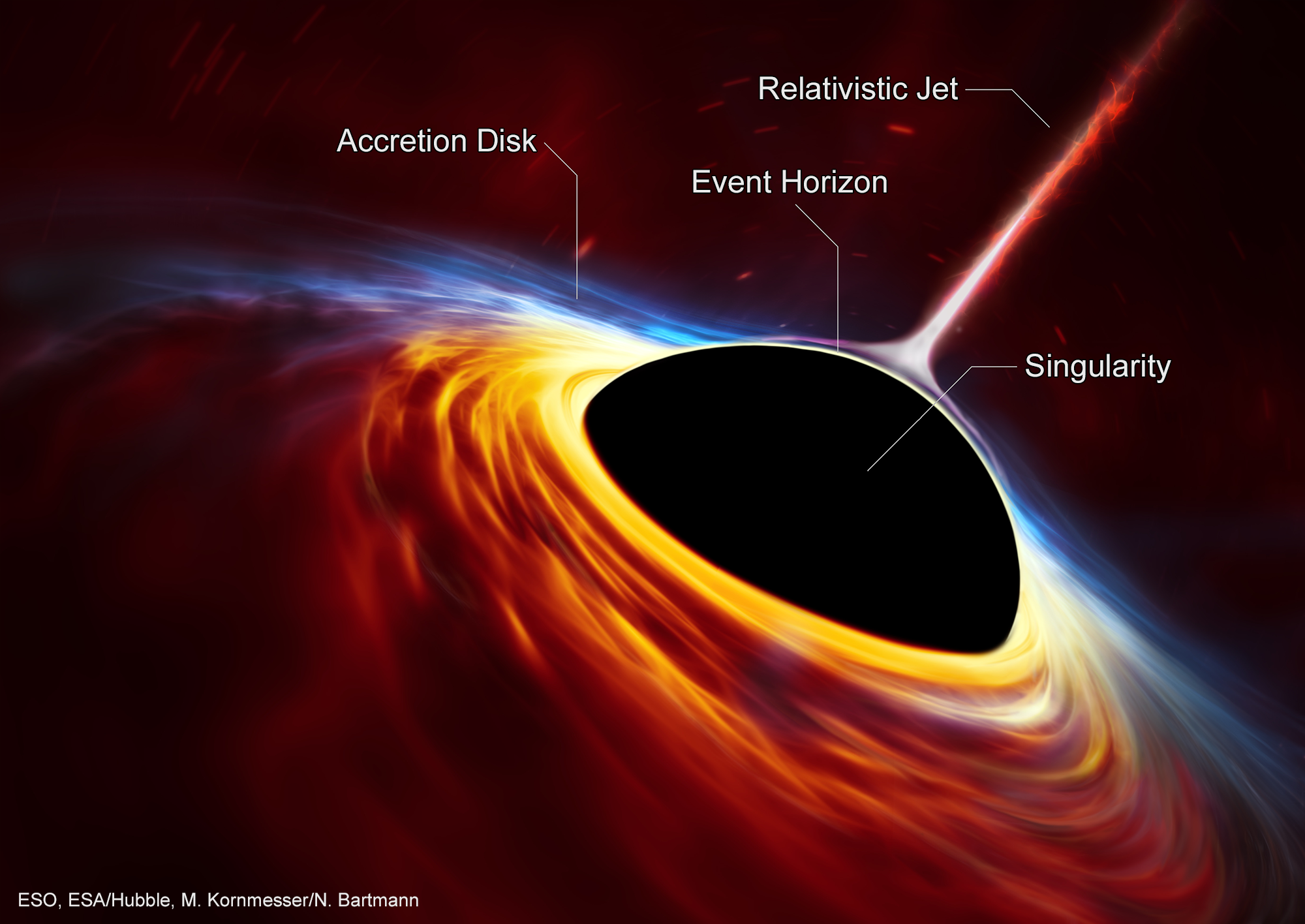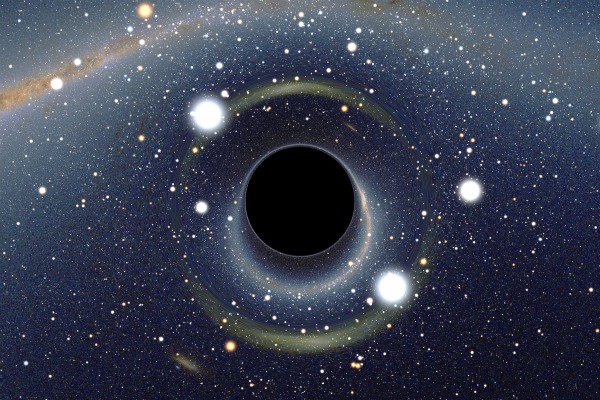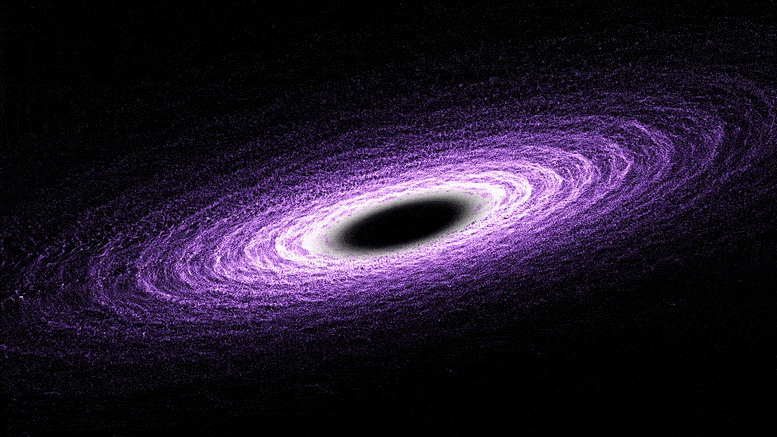- Carlisle Post Author. June 26, 2017 at 3:12 pm. The light that's reddening is coming from the person.before. they pass the event horizon. Think of the black hole like a hole at the bottom of a steeply sloping valley: the steep ground outside the hole is the space just outside the event horizon.
- A black hole is a hungry beast. It swallows up everything too close, too slow or too small to fight its gravitational force. With every planet, gas, star or bit of mass consumed, the black hole grows.
NSF press conference on first result from the Event Horizon Telescope project
Black Holes A black hole is a location in space that possesses so much gravity, nothing can escape its pull, even light. Learn more about what black holes are and the latest news. Black Hole USA: Advanced Fishing Technology. Exclusive Distributor of Black Hole USA Rods and Blanks worldwide. We mainly design rods/blanks for inshore, offshore, and big game fishing.
A global network of telescopes has been working to capture the first ever image of a black hole. On April 10 at 9 a.m. EDT, the National Science Foundation held a press conference to announce that an image of a black hole had been captured.
Download TranscriptJuly 12, 2018
Neutrino observation points to one source of high-energy cosmic rays
January 1, 2018
Supermassive black holes control star formation in large galaxies
December 7, 2017
Black holes' magnetism surprisingly wimpy
July 12, 2018
Neutrino observation points to one source of high-energy cosmic rays
January 1, 2018
Supermassive black holes control star formation in large galaxies
December 7, 2017
Black holes' magnetism surprisingly wimpy
Black Hole Researchers Katie Bouman and Colin Lonsdale Answer Your Questions
How EHT Captured an Image of a Black Hole
Event Horizon Telescope Animated Movie
How do you find a black hole?
Star gives birth to possible black hole
Black Hole Hunters Trailer
Primordial black holes
Formed from the condensation of raw materials in the early cosmos, primordial black holes emerged soon after the Big Bang. Most were extremely tiny, and while those with the lowest-mass have likely evaporated, primordial black holes with larger masses may still exist - though even those have remained undetected.
Stellar-mass black holes
The most common black holes form as the result of a supernova, the catastrophic death of a massive star. Most stellar-mass black holes are roughly five to ten times more massive than our sun, but NSF's Laser Interferometer Gravitational-Wave Observatory (LIGO) has detected several with masses up to 100 times that of our sun.
Intermediate-mass black holes
In the mass range between stellar-mass and supermassive blackholes - that is hundreds to hundreds-of-thousands of solar masses - are intermediate-mass black holes. Astronomers have spotted evidence for a handful of candidates, but none have been conclusively detected. Theorists believe there are three scenarios for their formation: They could be primordial black holes, they might have formed in environments dense with stars, or they formed from mergers of stellar-mass black holes.
Supermassive black holes
Supermassive black holes have masses ranging from millions to billions of solar masses and appear to be in the center of almost all galaxies. An important area of modern astrophysics is determining how supermassive black holes came to be: Were they formed with such high masses, or did their mass build up over time? The NSF-funded Event Horizon Telescope (EHT) project is attempting to capture an image of a black hole, setting its sights on two supermassive black holes, one in the center of the galaxy Messier 87 and the other in our Milky Way.
So, how does one study a region of space that is defined by being invisible?
Theorists can calculate properties of black holes based on their understanding of the universe, and such discoveries have come from a range of great thinkers, from Albert Einstein to Stephen Hawking to Kip Thorne. However, despite being so powerful, it's hard to see something that does not emit photons, let alone traps any light that passes by.
Now, nearly a century after scientists suggested black holes might exist, the world now has tools to see them in action. Using powerful observatories on Earth, astronomers can see the jets of plasma that black holes spew into space, detect the ripples in space-time from black holes colliding, and may soon even peer at the disc of disrupted mass and energy that surrounds the black hole's event horizon, the edge beyond which nothing can escape.
Event Horizon Telescope project
The Event Horizon Telescope is an international collaboration aiming to capture the first image of a black hole by creating a virtual Earth-sized telescope. Credit: Nimesh A Patel, Center for Astrophysics | Harvard & Smithsonian
NSF's Laser Interferometer Gravitational-Wave Observatory
LIGO detects gravitational waves, ripples in the fabric of spacetime. To date, the majority of LIGO discoveries have been waves created from black holes colliding. Credit: NSF/LIGO/Sonoma State University/A. Simonnet
Andrea Ghez and the UCLA Galactic Center Group
The Galactic Center Group studies the black hole at the heart of the Milky Way and how it impacts its surroundings, a multi-decade effort to better understand how galaxies formed and evolved. Credit: Aurelien Hees, Tuan Do, University of California, Los Angeles

NSF's National Radio Astronomy Observatory (NRAO)
NRAO manages several powerful radio telescopes that capture unprecedented images of the cosmos, including plasma jets and other evidence of black holes. Credit: Composite by Jayanne English, University of Manitoba; F. Schinzel et al.; NRAO/AUI/NSF; DRAO/Canadian Galactic Plane Survey; and NASA/IRAS.

NSF's LIGO
A century ago, Albert Einstein predicted gravitational waves -- ripples in the fabric of space-time that result from the universe's most violent phenomena. NSF-funded researchers, using one of the most precise instruments ever made -- the Laser Interferometer Gravitational-wave Observatory (LIGO) -- have detected gravitational waves that emanate from 1.3 billion years ago. Credit: Simulating eXtreme Spacetimes (SXS) project (http://www.black-holes.org)
Understanding NSF Research: Astronomy & Astrophysics
For more than 60 years, the National Science Foundation (NSF) has significantly advanced the understanding of the universe as the federal steward for ground-based astronomy. From its first contract to build the National Radio Astronomy Observatory, NSF has funded construction and operation of some of the world's most renowned telescopes, providing scientists with world-class instrumentation and facilities. Those investments have positioned the U.S. as a global leader in ground-based astronomy. Credit: European Southern Observatory/C. Malin
Accretion Disk | Credit: P. Marenfeld/NOAO/AURA/NSF
Blackholeboards.com
NSF Teleconference for Reporters on Unprecedented Black Hole Discovery in Nature | Credit: Gemini Observatory
Small Satellite Galaxy Pulled Into Supermassive Black Hole | Credit: Julie Turner, Vanderbilt University
Black Hole zoom background
Using the Event Horizon Telescope, scientists capture the first image of a black hole
Using the Event Horizon Telescope, scientists obtained an image of the black hole at the center of galaxy M87, outlined by emission from hot gas swirling around it under the influence of strong gravity near its event horizon.
Credit: Event Horizon Telescope collaboration et al.
Color in the supermassive black hole seen by the Event Horizon Telescope!
Color in the supermassive black hole seen by the Event Horizon Telescope! If you could fly next to the supermassive black hole M87*, this is what you would see. 55 million light years from Earth, at the heart of galaxy Messier 87, lies a monster black hole. Weighing in at 6.5 billion times the mass of our sun, it distorts spacetime like few objects in the universe. It has enshrouded itself in a swirling disk of super-hot energy and matter, and radiates unimaginably powerful jets above and below.
Credit: Nicolle R. Fuller/NSF
December 6, 2017
NSF statement on latest LIGO-Virgo detection of binary black hole merger
Jim Ulvestad, NSF acting assistant director for Mathematical and Physical Sciences, issues statement on detection of two 'light' black holes merging. Image Credit: LSC/LIGO/Caltech/Sonoma State (Aurore Simonnet)
October 16, 2017
Gravitational waves + new clues from space reveal new way to make a black hole
For the first time, scientists worldwide and at Penn State University have detected both gravitational waves and light shooting toward our planet from the birthplace of a new black hole created by the merger of two neutron stars. Image Credit: R. Hurt, Caltech/JPL
September 27, 2017
LIGO and Virgo observatories jointly detect black hole collision
Discovery launches new era of gravitational wave science. In August 2017, detectors on two continents recorded gravitational wave signals from a pair of black holes colliding. Image Credit: The Virgo collaboration/CCO 1.0
June 30, 2017
ALMA and the Event Horizon Telescope: Tip Sheet
The supermassive black hole at the center of our galaxy is hidden behind dense clouds of dust and gas. With the combined power of a worldwide network of radio telescopes, astronomers hope to peer into the heart of our galaxy and image -- for the first time -- the very edges of a black hole. Image Credit: NRAO/AUI/NSF
June 1, 2017
LIGO detects third black hole merger
NSF director reflects on the Laser Interferometer Gravitational-wave Observatory's latest detection and its significance. Taking us deeper into time and space in ways we couldn't do before the detection of gravitational waves. Image Credit: LIGO/Caltech/MIT/Sonoma State (Aurore Simonnet)
June 1, 2017
RIT's black hole computer simulations help ID third gravitational wave LSC announces newest findings
Rochester Institute of Technology (RIT) scientists working with the Laser Interferometer Gravitational-wave Observatory (LIGO) Scientific Collaboration (LSC) measured and interpreted the spin and alignment of a newly formed black hole detected on Jan. 4 by LIGO. Image Credit: LIGO Scientific Collaboration/RIT
April 5, 2017
Statement from NSF director on Event Horizon Telescope
Telescope network to try and capture image of supermassive black hole for first time. Image Credit: NSF/Stephen Voss
Black Holes In Space
June 22, 2016
Dormant black hole eats star, becomes X-ray flashlight
Telescope network to try and capture image of supermassive black hole for first time. Image Credit: NASA/Swift/Aurore Simonnet, Sonoma State U.
June 15, 2016
Gravitational waves detected from second pair of colliding black holes
LIGO Scientific Collaboration and Virgo collaboration identify second gravitational wave event using data from Advanced LIGO detectors. Image Credit: LIGO/T. Pyle
June 15, 2016
‘Mosh pits’ in star clusters a likely source of LIGO’s first black holes
Northwestern University astrophysicists have predicted history. They showed their theoretical predictions last year were correct: The merger of two massive black holes detected Sept. 14, 2015, could easily have formed through dynamic interactions in the star-dense core of a globular cluster. Image Credit: ESO/S. Brunier
April 6, 2016
Lonely black hole relic shines light on young universe
NSF-funded astronomers using the 8-meter Gemini North telescope on Hawaii's Maunakea have probed an enigmatic, and unexpected, supermassive black hole dominating the core of a large galaxy in the cosmic backwaters. Image Credit: NASA, ESA, and D. Coe, J. Anderson, and R. van der Marel (Space Telescope Science Institute)
February 11, 2016
Gravitational waves detected 100 years after Einstein's prediction
For the first time, scientists have observed ripples in the fabric of spacetime called gravitational waves, arriving at Earth from a cataclysmic event in the distant universe. Image Credit: LIGO Laboratory
Black Hole Of Calcutta
April 21, 2015
Planet-sized 'virtual telescope' expands to the South Pole to observe black holes in detail
Astronomers building a globe-spanning virtual telescope capable of photographing the 'event horizon' of the black hole at the center of our Milky Way have extended their instrument to incorporate the South Pole Telescope (SPT), a 280-ton radio telescope located at the National Science Foundation's (NSF) Amundsen-Scott South Pole Station in Antarctica. Image Credit: John Mallon III, NSF

November 20, 2014
'Blockbuster' science images
At this point, the blockbuster movie Interstellar has created such a stir that one would almost have to be inside a black hole not to know about it. And while the science fiction thriller may have taken some liberties with science to make its Hollywood plot work, the imagery comes straight from science — National Science Foundation – funded science, in fact. Image Credit: Jason Koski, Cornell University Photography
July 11, 2014
Exploring dramatic changes in galaxies
The evolution of galaxies over billions of years offers any number of tantalizing clues about the origins of the universe. Alison Coil is trying to solve some of these mysteries by studying how galaxies have been changing over time, and why. Image Credit: Alison Coil, UCSD
April 14, 2014
Cosmic slurp
Somewhere out in the cosmos an ordinary galaxy spins, seemingly at slumber. Then all of a sudden, WHAM! A flash of light explodes from the galaxy's center. Image Credit: NASA, S. Gezari (The Johns Hopkins University), and J. Guillochon (University of California, Santa Cruz)
February 18, 2014
Let there be light
Black holes may be dark, but the areas around them definitely are not. These dense, spinning behemoths twist up gas and matter just outside their event horizon, and generate heat and energy that gets radiated, in part, as light. Image Credit: NASA's Goddard Space Flight Center/J. Schnittman, J. Krolik (JHU) and S. Noble (RIT).
August 15, 2012
NSF's South Pole Telescope Discovers a Galaxy Cluster Creating Stars at a Record Pace
A National Science Foundation-funded radio telescope in Antarctica has found an extraordinary galaxy cluster that may force astronomers to rethink how galaxy clusters and the galaxies that inhabit them evolve. Image Credit: Dr. Keith Vanderlinde
December 5, 2011
Sleeping Giants Discovered
Astronomers recently discovered the most massive black holes to date. Found in two separate nearby galaxies roughly 300 million light years away from Earth, each black hole has a mass equivalent to 10 billion suns. Image Credit: Gemini Observatory/AURA illustration by Lynette Cook
February 2, 2009
Astronomers Discover Link Between Supermassive Black Holes and Galaxy Formation
A pair of astronomers from Texas and Germany have used a telescope at The University of Texas at Austin's McDonald Observatory together with Hubble Space Telescope and many other telescopes around the world to uncover new evidence that the largest, most massive galaxies in the universe and the supermassive black holes at their hearts grew together over time. Image Credit: NASA/AURA/STScI and WikiSky/SDSS
April 23, 2008
Catching a Glimpse of a Black Hole's Fury
Using the National Science Foundation's (NSF) Very Long Baseline Array (VLBA) and a host of international telescope partners, a team of researchers has made the clearest observation yet of innermost region of a black hole. Image Credit: Marscher et al., Wolfgang Steffen, Cosmovision, NRAO/AUI/NSF
April 2000
7. Black Holes Confirmed - Nifty 50
The question of what lies in the center of our Milky Way Galaxy has been one of science's major unanswered questions. Image Credit: Chad Baker/Thinkstock
September 7, 1998
'Supermassive' Black Hole Found in the Center of Our Galaxy
The question of what lies in the center of our Milky Way Galaxy has been one of science's major unanswered questions. Image Credit: Gemini Observatory
